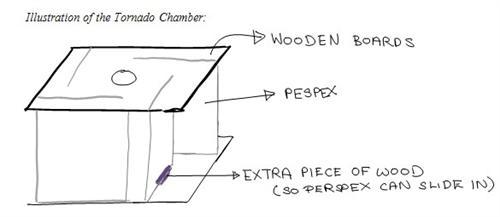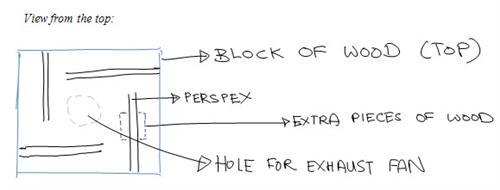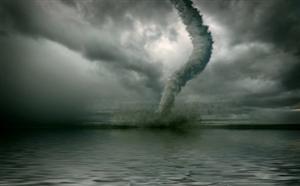| Complexity level: | 6 |
| Project cost ($): | 30 |
| Time required: | 3 to 4 hours for preparation and observation |
| Material availability: | Materials should be obtainable from nearby departmental stores |
| Safety concerns: | Students should take precautionary steps by wearing protective gears such as mask and gloves at all times. Adult supervision is required as students are handling sharp objects such as the saw. Be careful when handling the dry ice. |
Hypothesis
The higher the water temperature, the larger the diameter of the tornado’s core.
Overview
How are tornadoes formed?
In countries such as the U.S., tornadoes are formed as frequent as from several hundreds a year to several thousands, maybe even tens of thousands! In general, tornadoes and hurricanes are very similar. A tornado (or hurricane) starts forming itself in a major thunderstorm known as a supercell. Supercells are thunderstorms that last longer than usual thunderstorms. As wind meets these storms (or supercells), they swirl and begin to form a funnel. The atmosphere in the funnel rotates more and more rapidly which results in a low pressure area which absorbs more air and maybe even objects into it!
The thunderstorms which create tornadoes are formed when warm moist tropical air collides with cold dry polar air.
Which countries are affected by tornadoes?
Southern Africa, New Zealand, South America, Central European Countries, Italy, Australia and the United States are countries worst affected by tornadoes.
People are warned about an upcoming tornado by certain organizations such as the Storm Prediction Center. Households in tornado zones mostly have in built underground shelters to remain safe during a tornado attack. As soon as the people receive news about an upcoming attack, they immediately rush to the basement shelter and remain there until the tornado subsides. People can get the news of an upcoming attack via radio reports and television news report. However, inhabitants should stay alert themselves at all times in case all else fails. There’s a high chance of an upcoming attack if the sky has a sudden change of colour from blue to greenish black and the clouds are moving faster than usual.
Materials
- Electrical drill
- 4 Perspex (windshield glass) of about 20cm X 30cm
- 2 wooden boards of about 25cm X 25cm
- 4 wooden blocks of about 5cm X 15cm
- Bathroom exhaust fan
- Measuring tape
- Dry ice
- Extension cord
- Metal plate
- Hot water
- Gloves
- Stopwatch
- Superglue
Procedure
Building the tornado chamber:
- Use the 2 wooden boards as the base and top for the chamber.
- Cut the Perspex into 4 pieces, each measured to fit the 4 sides of the wooden boards (acting as the walls of the chamber) with gaps.
- Also, prepare the 2 wooden blocks, which serves the purpose of sliding a Perspex ‘wall’ into place.
- Overall, it should look something like the diagram below:
- Make a hole of about 7cm in diameter on the top wooden board to fit the bathroom exhaust fan
- Glue 2 wooden blocks onto the top and bottom boards each. The width between the 2 blocks should be equal to the thickness of the Perspex.
- Drill or hammer the various components together
- Fit the fan into position and connect the electrical wires. Remember to add a power (on/off) switch for the exhaust fan.


Carrying out the experiment:
- For this experiment, the controlled variable is the water temperatures, which are 10, 20, 30, 40 and 50 degree Celsius respectively. The diameter of the core of the tornado is the dependent variable for this experiment. A few constant variables are the amount of dry ice used, the size of the chamber and the speed of the exhaust fan.
- Prepare the sample of water one at a time as the temperature needs to be carefully monitored.
- Heat or chill the water to a temperature of 10 degrees Celsius. Use a microwave or a refrigerator/freezer to help speed up the process.
- When the optimum temperature is reached, remove the detachable side of the wall by carefully sliding it out of position, and place the plate of water at the center of the chamber.
- Using the pair of gloves, place 200 grams of dry ice in the middle of the water. Hold it firmly in the middle till it sets in position
- Reposition the removable wall
- Turn on the exhaust fan. Start the timer.
- After a minute, you should be able to observe the early stages of formation of the tornado. Using the measuring tape, roughly measure the diameter of the tornado’s core.
- After you have completed step 5, repeat all the steps for the different water temperatures of 20, 30, 40 and 50 degree Celsius respectively and
- Record your observations.



Results
The following are the results obtained.
| Water temperature (Degree Celsius) | 10 | 20 | 30 | 40 | 50 |
| Diameter of the tornado’s core (Cm) | N/A | 7 | 15 | 11 | 6 |
The diameter is negligible when the water is 10 degree Celsius.
The diameter is 7cm when the water is 20 degree Celsius.
The diameter is 15cm when the water is 30 degree Celsius.
The diameter is 11cm when the water is 40 degree Celsius.
The diameter is 6 cm when the water is 50 degree Celsius.
Conclusion
The hypothesis is not accepted because as the water temperature is increased, the diameter of the core of the tornado does not increase accordingly. The diameter was largest when the water was about30 degrees Celsius.
The destruction left in the wake of a hurricane is very large – homes are destroyed and lives may be lost. Hence, it is important to know how tornadoes are formed in order to predict the formation of a tornado and warn the public about an upcoming attack. Though difficult to understand, years of thorough research and experiments have let us to understanding more of the science behind the formation of tornadoes.
Also consider
What would happen if more temperatures were used in this experiment? Can you find the peak when the diameter would be at its largest?
What difference would you observe if the size of the chamber was increased/ decreased?
Would a change in the gap size affect the tornado formation? Why?
References
http://www.mapsofworld.com/referrals/weather/severe-weather-conditions/tornado-safety.html
http://www.windows.ucar.edu/tour/link=/earth/Atmosphere/tornado/formation.html&edu=mid

